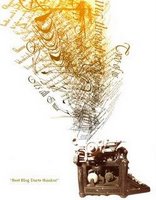Wednesday night, we drove to Gulfport and met my parents, who (lucky for us!) have a Rebel XT (the newer version of my camera) that they were willing to lend us for awhile. New camera! I have been using mine exclusively for awhile now; I’d forgotten the difference in the newer models… particularly that (with my 50mm 1.4) it does so much better in lower light. Thursday afternoon, while Paul was in a Board Meeting, I helped out at the school and played with the camera… err… the kids. I didn’t take many of my kids — but I did get Kate walking around with her ruffle butt (above). I’m still trying to get used to the subtle changes in setting and feel. All of these pictures were taken without flash, which is pretty good considering the coloration the tungsten light. I shoot a lot indoor (reality of kids) — so I’d like to experiment more with white balance and an 80A filter.
Will specifically asked me to take pictures of him eating his pudding. Will’s method of having his picture taken is that he begins to move as many body parts as fast as he can all at once. It was a miracle to get this, especially without flash in such low light!
{ 2007 04 13 }















Matt | 13-Apr-07 at 9:35 pm | Permalink
Re: white balance and filters.
I’ve not had much need for a color-based filter for any of my digital cameras. I always use an uv/haze filter for protection of the front element and take that off to use a circular polarizer at times when shooting outside or against glass.
From my very first digital camera forward I have found it very important to experiment with white balance settings and know how the camera behaves in certain cases. On some cameras auto works very well in many circumstances, on others, not so many. One thing has rung true for me, though, using full-sun wb preset for sunsets yields colors that ring true to my eyes.
Anyway, shoot RAW with auto (or preset based on environment). Change the white balance in post processing later if it’s off. With RAW the white balance setting does not effect your final output. With JPG you can adjust it, but you will have some loss in the conversion that does not exist when shooting RAW.
If you’re really interested in a “filter” for a specific setting, get a grey card and take a white-balance reference photo in the lighting where you’ll be shooting. You can use that to later adjust white balance in post processing. I don’t know about the Rebel XT, but you may be able to tell the camera itself (through the menu) to use the shot of the grey card to set its notion of white balance (often called custom or reference white balance). Then it should be spot on for the lighting as long as the lighting conditions don’t change.